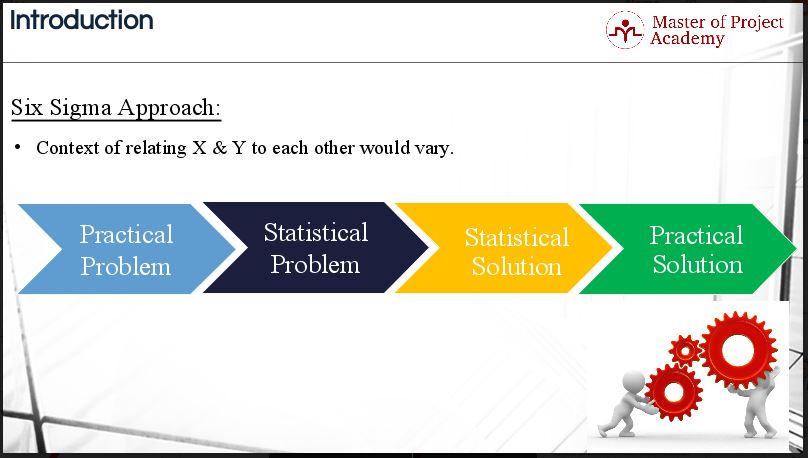If you are a project manager or an engineer, you may have heard of the 6 Sigma approach to problem-solving by now. In online Six Sigma courses that teach the Six Sigma principles, you will learn that a data-driven approach to problem-solving, or the Six Sigma approach, is a better way to approach problems. If you have a Six Sigma Green Belt certification then you will be able to turn practical problems into practical solutions using only facts and data.
Attend our 100% Online & Self-Paced Free Six Sigma Training.
This approach does not have room for gut feel or jumping to conclusions. However, if you are reading this article, you are probably still curious about the Six Sigma approach to problem-solving.
What is the Six Sigma Approach?
Let’s see what the Six Sigma approach or thinking is. As briefly described in free Six Sigma Green Belt Certification training, this approach is abbreviated as DMAIC. The DMAIC methodology of Six Sigma states that all processes can be Defined, Measured, Analyzed, Improved and Controlled. These are the phases in this approach. Collectively, it is called as DMAIC. Every Six Sigma project goes through these five stages. In the Define phase, the problem is looked at from several perspectives to identify the scope of the problem. All possible inputs in the process that may be causing the problem are compared and the critical few are identified. These inputs are Measured and Analyzed to determine whether they are the root cause of the problem. Once the root cause has been identified, the problem can be fixed or Improved. After the process has been improved, it must be controlled to ensure that the problem has been fixed in the long-term.
Check our Six Sigma Training Video
Every output (y) is a function of one or multiple inputs (x)
Any process which has inputs (X), and delivers outputs (Y) comes under the purview of the Six Sigma approach. X may represent an input, cause or problem, and Y may represent output, effect or symptom. We can say here that controlling inputs will control outputs. Because the output Y will be generated based on the inputs X.
This Six Sigma approach is called Y=f(X) thinking. It is the mechanism of the Six Sigma. Every problematic situation has to be converted into this equation. It may look difficult but it is just a new way of looking at the problem.

Please remember that the context of relating X and Y to each other would vary from situation to situation. If X is your input, then only Y becomes your output. If X is your cause, Y will not be regarded as the output. If X is your input, Y cannot be called as an effect.
Let’s go further. The equation of Y=f(X) could involve several subordinate outputs, perhaps as leading indicators of the overall “Big Y.” For example, if TAT was identified as the Big Y, the improvement team may examine leading indicators, such as Cycle Time; Lead Time as little Ys. Each subordinate Y may flow down into its own Y= f(X) relationship wherein some of the critical variables for one also may affect another little Y. That another little variable could be your potential X or critical X.
A practical vs. a statistical problem and solution
In the Six Sigma approach, the practical problem is the problem or pain area which has been persisting on your production or shop floor. You will need to convert this practical problem into a statistical problem. A statistical problem is the problem that is addressed with facts and data analysis methods. Just a reminder, the measurement, and analysis of a statistical problem is completed in Measure and Analyze phase of the Six Sigma approach or DMAIC.

In this approach, the statistical problem will then be converted into a statistical solution. It is the solution with a known confidence or risk levels versus an “I think” solution. This solution is not based on gut feeling. It’s a completely data-driven solution because it was found using the Six Sigma approach.
A Six Sigma approach of DMAIC project would assist you to convert your Practical Problem into Statistical Problem and then your Statistical Problem into Statistical Solution. The same project would also give you the Practical Solutions that aren’t complex and too difficult to implement. That’s how the Six Sigma approach works.
This approach may seem like a lot of work. Wouldn’t it be better to guess what the problem is and work on it from there? That would certainly be easier, but consider that randomly choosing a root cause of a problem may lead to hard work that doesn’t solve the problem permanently. You may be working to create a solution that will only fix 10% of the problem while following the Six Sigma approach will help you to identify the true root cause of the problem. Using this data-driven Six Sigma approach, you will only have to go through the problem-solving process once.
The Six Sigma approach is a truly powerful problem-solving tool. By working from a practical problem to a statistical problem, a statistical solution and finally a practical solution, you will be assured that you have identified the correct root cause of the problem which affects the quality of your products. The Six Sigma approach follows a standard approach – DMAIC – that helps the problem-solver to convert the practical problem into a practical solution based on facts and data. It’s very important to note that the Six Sigma approach is not a one-man show. Problem solving should be approached as a team with subject matter experts and decicion makers involved.



20 thoughts on “The Six Sigma Approach: A Data-Driven Approach To Problem-Solving”
Comments are closed.